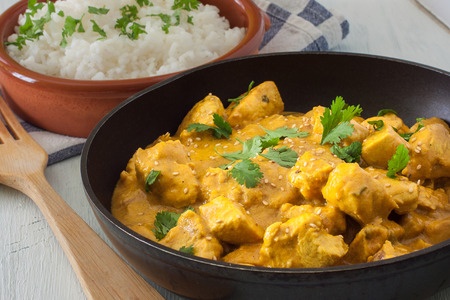
Editing and writing have a lot in common with cooking. For one thing, people come to a text, as to a restaurant, with certain expectations and ideals, and you should satisfy them. You don’t have to give them something completely predictable — especially if you’re in a line more artistic than industrial — but you do want to curry their favour.
That puts me in mind of a recipe in the Larousse Gastronomique, 1977 English edition: “Chicken curry (Plumerey’s recipe).” The listed ingredients are two chickens (cut up), butter, 500 grams of diced uncooked ham, a tablespoon of flour, light veal stock to moisten, a bouquet garni (a standard French seasoning made of a bundle of herbs), and two teaspoons of curry powder.
I don’t think you’ll be served that recipe at any restaurant today. It would seem weirdly out of place (and just weird) in a French restaurant, and it would get the chef in an Indian restaurant fired. But there was a time when French cuisine was considered by many to be the apex of the culinary world, and anything you might eat could be “improved” by a French touch. Even curry.
Likewise, there was a time when a single standard prevailed throughout most of literature. Even if a given work didn’t meet that standard, it was understood that that was what it was aiming for. Certain things were simply infra dig, my dears. Other standards were sub-standard. It was important to show you had the right sort of education.
That time is past. Just as we no longer consider French ingredients and techniques the basis of all the best food, we — or many of us, anyway — are now wise enough not to think that starchy formal English is necessary or even appropriate everywhere. There are, alas, still some people who believe that an overarching consistent adherence to a single standard is the goal of writing and editing. If a writer aiming a rambunctious piece at an informal audience puts “There’s a couple things you should know,” such an editor will tut-tut and change it to “There are a couple of things you ought to know” — or “a few things” if there are more than two. Never mind that that changes the flavour completely; somehow, a palate that can’t taste the difference is supposed to be better.
And perhaps such an editor would be pleased to be served a curry cooked to the standards of Carême. For everyone else, let’s use appropriate ingredients and techniques. English — like any living language — has a multitude of styles suited for different contexts and people. When we recognize that and work with it, we aren’t letting go of rules, we’re choosing which rules to use to suit the occasion. When people come to a French restaurant, give them the best French cuisine, sure. When they come to a chain restaurant, give them a consistent demotic product. And if they’re after good barbecue, or tortellini, or nuer pad prik, or vindaloo, leave Larousse on the shelf.
~~~
Previous “Linguistics, Frankly” post: The Hardest Language.
The Editors’ Weekly is the official blog of Editors Canada. Contact us.
Discover more from The Editors' Weekly
Subscribe to get the latest posts sent to your email.
